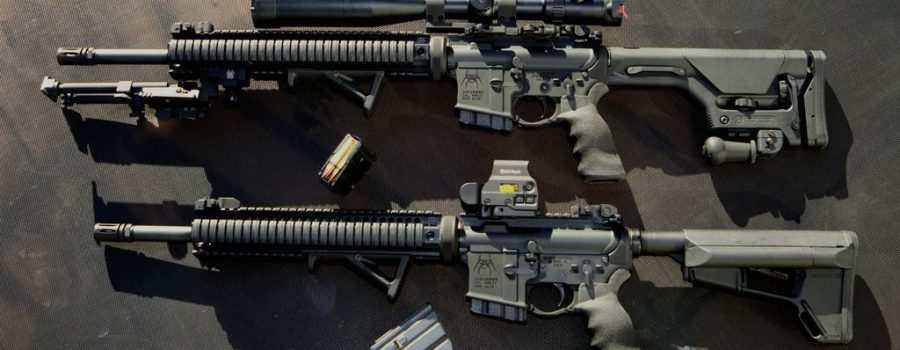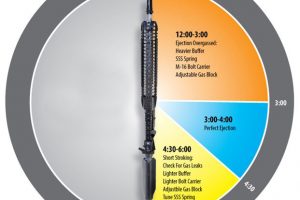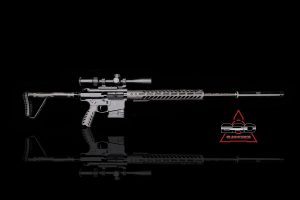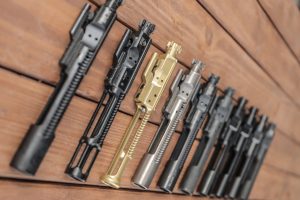The firearms world is a funny thing. The majority of enthusiasts always rush on to the next popular “thing” as soon as it hits the market. Right or wrong. Without worry of pro’s and con’s, or whether it fits their requirements. For a long time, during the ’94 assault weapons ban, everyone jumped on the heavy barrel (HBAR) bandwagon. By 2010 and still today, the trend is to make everything as light as possible.
It’s important to note that there’s a very important missing element there. But first, how about a bit of history. The M-16 sported a lightweight “pencil” barrel when it first came onto the scene, though it was called the “standard” profile at the time. In all, the package was around 6.9 lbs. Nobody thought anything of it until some armorers kept getting reports of bent barrels. When the product improvement program got started, one of the tasks was to “fix” the bent barrel problem.
The end result of the A2’s efforts to fix the “problem” was thickening the muzzle end of the barrel forward of the gas block and bayonet lug. The A2 program increased the weight of the whole rifle approximately 7.8 lbs, and had another effect of shifting the balance of the rifle quite a bit more forward. And that gets me to the topic today.
The Rifle Weight Pendulum
Even though the original M-16A1 had a lightweight barrel, it wasn’t the only variant of AR-15 available at the time. In 1964, Colt started producing heavy-barreled models for use as light machine guns. And, as I mentioned earlier, heavy-barreled models gained popularity during the 1994 Assault Weapons Ban.
Personally, I don’t think this had to do with their usability so much as it was marketing tactics by gun companies “convincing” the public that they needed one. After all, this is how most big company marketing works. HBAR models are cheaper to produce without the extra time machining the profile, so they stood to make more money in a slowed market. Another reason might be that some states consider the HBAR models to be “sporting” rifles, and allow them to be sold in the state where AR-15s are otherwise banned.
In either case, rifles grew heavier. The HBAR models added about another pound to the weapon and shifted the balance even further forward. As the War on Terror picked up, I noticed a distinct turn back towards lightweight configurations. Around 2010 to 2012, pencil-barreled models began dominating the enthusiast community.
As individuals gained experience in conflict and returned home to share what they learned, the AR-15 world became more about defensive use rather than high-power matches. Notably, this is the transition to what is known as Gun Culture 2.0. As anyone who has had to carry stuff for long periods will tell you, weight matters. Ounces become pounds, and pounds become pain. The benefits of heavy barrels are not relevant for the average self-defense minded shooter, so why cause the extra pain? What does that weight do for you?
The Effects of Weight
There are really only two things that come to mind when we talk about the effects of total weight. I want to be clear here, I’m talking about the total weight of the rifle and everything bolted on to it. Heavy barrels, in isolation, are a slightly different subject and right now we’re just going to focus on the total weight.
Physical Exertion
The heavier a rifle becomes, the more of a pain in the ass it is to carry. I can hear the internet commandos out there right now howling to “get stronger.” While the goal of getting stronger is always valid, and is something we should aspire to, that’s the wrong answer.
It’s no different than the military visiting and revisiting the concept of an LR308 platform AR battle rifle. Those in the know, know that the increased weight of the rifle, which is tremendous, as well as the increase of weight of .308 ammunition would result in a lesser loadout for the gun. All of which are disadvantages. What advantages are gained? None really. With current military ammo there is no gain in ballistics over the 5.56 NATO, and all of the cartridges that are available for it. Then you have to be able to look at supply chains and whatnot. It would then also become more difficult to traverse walls, fences, and other obstacles due to the weight, as well as slow movement due to fatigue when the overall big picture is looked at. These are some factors why the 5.56 NATO cartridge is still the intermediate cartridge in the AR platform.
I can’t remember which trainer it was that said it, but I thought they put it well. “Get stronger” is fine to a point, but we need to think of it differently. If the capability we gain for having a heavier weapon is worth the weight, then let’s do it. Many a grunt will complain about having to lug the 240 around, but nobody will complain about what it brings to the fight.

Carrying a 12lb AR-15 that doesn’t do anything better than a 9lb AR-15 except having more junk bolted to it is a different story. Pounds add up to pain and are a bigger drain on your physical resources. Don’t make your life more difficult.
For marksmanship, total weight also negatively affects performance, especially from the standing position. The exception is that most supported positions, especially from a bench rest or bag, will have little to no effect on accuracy. There was some research performed in 1997 that actually tested this, and found that heavier rifles led to greater fluctuations in muscle movement, which negatively affected aiming. But that’s not the whole story. If that were true all of the time, then why do high power shooters insert weights into their rifles to make them even heavier?
Recoil Management

It’s pretty obvious that weight does affect recoil management. Consider the ballistics of a rifle. The recoil you feel as you fire a rifle is the combined energy of the bullet mass and expanding gasses exiting the muzzle away from you. It’s like a mini missile. Increasing the mass of the rifle also increases the required energy to exert force against you. Hence, heavier rifles mean less felt recoil because they are able to absorb some of that energy in their mass. This is why so many PRS competitors are running around with 15 to 17 lb rifles, or more. To get this weight it is not uncommon for them to attach specialty weights to rails if they are using an AR platform gun, or to put weight in the stock.
On Rifle Balance
Another topic is balance, and this is a term that I have yet to see defined by a majority opinion. A lot of people talk about how a rifle balances, without ever really discussing what that means. The simple truth is that everyone has a different preference. Most people find a rifle to be well-balanced when the center of gravity falls somewhere around the middle of the weapon. I think that’s a fair description, but I also talk about it in terms of falling between the firing and support hands.
You can shift the balance point of your rifle by adding weight to either the front or the rear. While doing this in either direction adds to the overall weight of the weapon, you might find that doing so also dramatically changes how the rifle feels and handles. I’ve seen several cases where adding weight to the rifle in the right place actually made it easier to handle. This can show during reloads, when moving, when transitioning targets, when shooting from barricades or other abnormal supports, as the magazine capacity is being lowered due to expending rounds, etc.
In general, the rifle feels “livelier” and easier to point as you shift the balance point rearward towards the stock. In weapons with a heavy rearward balance, like bullpups, it’s easy to shoulder and fire the weapon with a single hand. The rearward balance is quicker to snap onto target from a low or high ready position, it feels quicker and snappier to transition from target to target. It is easier to brake once on target. However, I’ve found that strong rearward balance also makes the muzzle less steady. This may matter if you require offhand shooting at distant targets, or if you’re looking for the utmost precision offhand.
Conversely, a forward balance helps steady the muzzle and absorb some of these movements. This is one advantage of the government profile barrel. This is sometimes referred to as “hang” due to the length and/or extra barrel profile weight “hanging” out front. Of course, a front-heavy weapon also feels heavier than it actually is. It’s slower to bring to the ready, and slower to move from target to target. Another effect of a forward balance is this. You may not notice it without someone telling you to look for it, but if you have a forward weight bias – meaning that you’ve moved the center of gravity forward from the “stock” position – as you expend ammunition, the weapon will become slightly more nose heavy, because weight is being reduced at a point behind the CG, thereby shifting it forward. This has the ability to change shooting dynamics.
But what about a neutral balance, or center of gravity? A neutral balance will have the center of gravity at the magwell so that the weapon has the same center of gravity with a full mag or an empty one. With the center of gravity behind the magwell, the front of the weapon will become lighter as the mag empties. Or actually, as the center of gravity gets farther away from the magwell, you’ll get more variation in where the center of gravity is between full and empty magazines.
Finding the Middle Ground

I can’t tell you what you’re going to like. Everyone has a preference. That preference may change based upon what the purpose of the rifle is for. This is why I’m always preaching to determine what the purpose of your AR is for before buying or assembling one. The purpose will dictate so much of what goes into the gun. Is it an AR pistol that will be used in urban CQB style environments, as a home defense weapon or will it be a vehicle gun? Is it a patrol carbine that will bridge the gap between an AR pistol and a Recce rifle? Is it meant for long range precision shooting? Etc. You need to find what works for you and make it consistent.
I personally prefer most of my AR platform guns to balance around the front half of the magazine well. So a neutral to slightly rearward bias. But there are exceptions. I always use quality components. To keep weight down I do avoid excess weight where I can but only without sacrificing performance or dependability. Under no circumstances do I use skeletonized components, low mass BCG’s, or other absurd items on a defensive or duty gun. Now there may be times that I would use low mass or skeletonized parts on an AR build but it would be very specific such as a USPSA PCC competition gun or something similar. Again, be purpose driven.
While I rarely use lightweight profile barrels in any AR, your needs may be different. Depending on your requirements, consider going heavier than a lightweight barrel for some applications. As in example, in my Recce or SPR guns I use a medium weight SPR profile style barrel. I do this precisely because of my experience with “jumpiness” and higher magnification optics. In those circumstances, I’d rather have a little extra weight on the barrel and save weight elsewhere. That also gives just a bit more hang. Not to mention that for my intended purposes, most shots at distance will be from some sort of a supported position.
Let’s change gears for a minute. Do you recall hunting rifles following this same evolution? For a while, it seemed like everyone was trying to make super light rifles with skinny barrels and flimsy stocks. You can get away with that for say a .223 Remington, but I would be concerned firing a 7mm mag or similar like that. But, with a few exceptions such as “mountain guns,” I’ve noticed a pivot back to medium-weight barrels and lightweight stocks.
Accessories

These are items that so many people do not give thought to. Weight of accessories. Size of accessories. Where they are mounted. How they are mounted. Etc.
I’m not going to say much about this but I will preface it with “form follows function.” Not the other way around. This mainly applies to mounting of some optics for say proper eye relief. Or the positional mounting of white lights. Just like we don’t sacrifice performance or dependability for weight, we do not sacrifice functionality for balance.
Within reason we do have some say with certain accessories though. Take a red dot. Most red dot optics can be placed on the upper rail in few different positions. To aid in balancing most of my AR pistols that are equipped with red dots I find that they are on the front half to front edge of the ejection port. I have no issues with dot visibility and this also provides me with a secondary advantage of opening up my field of view as the red dot sight doesn’t occupy and block most of view.
We can also look at materials and accessory mounting styles. Take a handstop or vertical foregrip. Does it really need to be aluminum? Maybe. Really depends on plausible environmental and use conditions that it may see. But a strong polymer from a reputable manufacturer may work just as well.
What about accessory mounts? Do you really need to add that pic rail attachment to your M-Lok rail to mount an accessory? Again maybe and maybe not. But if you don’t have too you will be reducing weight as well as streamlining your AR just a bit more which aids in reducing the chances of snagging it on something.
What about your white light mount? Does it really need that pic rail mount? Good chance that it doesn’t as there are a number of accessory mounts on the market that it can be converted to. Is there a mount that is stronger and lighter? Possibly. Can we pull that light in closer to the rail? Most likely but it will also depend on what else is mounted on the rail. Like say a PEQ module, MAWL, or something else.
What about backup iron sights? Do we really need to have that front sight clear out on the end of the gun? Maybe. But if you have other accessories out there such as say a tape switch for a white light or a PEQ module, chances are good that that sight isn’t going out on the end. That’s ok though. It can be positioned closer. There was research done as to the optimal distance between backup iron sights and IIRC it is like around 13”, but I’m not sure and while I have it written down somewhere around here I can’t find it. Sorry. So even if you have room on your rail clear out at the end, you may choose to mount the front sight closer to the magwell anyway.
Final thoughts?
Remember, define the purpose. Form follows function. Then find your preference.
Some people like the weight to be on the front of the rifle. They load up their rail system with lights, vertical foregrips, bipods, etc., over a heavy barrel profile, and with a standard or lightweight aftermarket stock out back. Others like a rear bias and they’ll get a Magpul UBR and stick it on a lightweight rifle with a pencil barrel and a pistol light on the handguard. Finally, some prefer a neutral balance.
How often have you considered both weight and balance in your projects? What’s your preferred way of handling it? Has this article enlightened or changed your mind about your set-up?
BRD Gun Works~ Performance you can afford when you can’t afford failure



